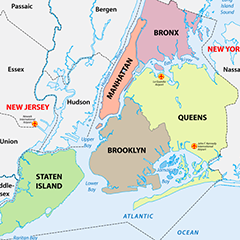New York State’s Department of State (DOS) has completed a two-year study to generate and assemble the most comprehensive dataset of physical, biological, geographic, and socioeconomic information available for the Atlantic Ocean waters. For planners and wind farm operators planning on expanding into this wind-rich territory, it’s essential reading…
New Yorkers rely on the ocean for a wide range of economic activities. Over two-thirds of them live in counties that are located within the State’s ocean and estuarine regions, accounting for over 275,000 ocean and coastal-related jobs and nearly $7.5 billion in wages in 2009.
The Port of New York and New Jersey is North America’s largest container port and the third biggest port in the United States, handling over $175 billion in cargo. The overall economic contributions of the sport fishing, commercial fishing, and seafood industries to New York State total $11.5 billion annually.3 Long Island’s tourism industry accounts for over $4 billion annually and includes a robust community of recreational divers, boaters, fishers, and others who enjoy using the water. In fact, New York has the largest concentration of registered recreational boats in the Northeast, with Suffolk and Nassau Counties accounting for almost two-thirds of the 15,502 total vessels in New York.
In addition to these important economic activities, New York’s coastal communities are deeply connected to the ocean by physical and ecological ties. In the past, severe coastal storms have caused significant damage to New York’s coastal communities because of this connectivity. Most recently, in October of 2012, Hurricane Sandy’s high winds and related storm surge devastated portions of New York City and Long Island, causing fatalities, injuries, property damage and extended power outages, and disrupting life for millions of New Yorkers. Taking a longer view, the ocean-related impacts of climate change will pose additional strains on coastal communities.
Warming ocean temperatures and rising sea levels will affect coastal infrastructure, and the distributions of fish stocks and other wildlife may shift farther north. While the focus of this study is on offshore areas, understanding the relationship between New Yorkers and the ocean will provide insight into opportunities to strengthen and improve connections to the ocean, leading to more economically-vibrant communities that are also more resilient.
In acknowledgement of the breadth of connections between New York’s coastal area and the offshore environment, DOS studied an expansive area. In its entirety, the offshore planning area constitutes approximately 12,650 square nautical miles (16,740 square miles) off the south shore of New York City and Long Island. These waters are under the jurisdiction of either the state (0-3 nautical miles from shore) or federal (3-200 nautical miles) governments, and are managed bynumerous government agencies. Through the New York State Coastal Management Program, authorized by the federal Coastal Zone Management Act (CZMA) and administered by DOS, New York has an important role in federal decisions made in waters beyond the State’s territorial boundary through its Federal Consistency authority.



























